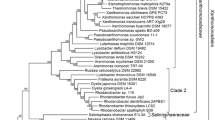Abstract
Since previous interspecies comparisons of Caulobacter genomes have revealed extensive genome rearrangements, we decided to compare the nucleotide sequences of four C. crescentus genomes, NA1000, CB1, CB2, and CB13. To accomplish this goal, we used PacBio sequencing technology to determine the nucleotide sequence of the CB1, CB2, and CB13 genomes, and obtained each genome sequence as a single contig. To correct for possible sequencing errors, each genome was sequenced twice. The only differences we observed between the two sets of independently determined sequences were random omissions of a single base in a small percentage of the homopolymer regions where a single base is repeated multiple times. Comparisons of these four genomes indicated that horizontal gene transfer events that included small numbers of genes occurred at frequencies in the range of 10−3 to 10−4 insertions per generation. Large insertions were about 100 times less frequent. Also, in contrast to previous interspecies comparisons, we found no genome rearrangements when the closely related NA1000, CB1, and CB2 genomes were compared, and only eight inversions and one translocation when the more distantly related CB13 genome was compared to the other genomes. Thus, we estimate that inversions occur at a rate of one per 10 to 12 million generations in Caulobacter genomes. The inversions seem to be complex events that include the simultaneous creation of indels.





Similar content being viewed by others
References
Ash K, Brown T, Watford T et al (2014) A comparison of the Caulobacter NA1000 and K31 genomes reveals extensive genome rearrangements and differences in metabolic potential. Open Biol 4:140128. https://doi.org/10.1098/rsob.140128
Berrios L, Ely B (2018) Achieving accurate sequence and annotation data for Caulobacter vibrioides CB13. Curr Microbiol 75(12):1642–1648. https://doi.org/10.1007/s00284-018-1572-3
Bolotin E, Hershberg R (2017) Horizontally acquired genes are often shared between closely related species. Front Microbiol 8:1536. https://doi.org/10.3389/fmicb.2017.01536
Boto L (2015) Evolutionary change and phylogenetic relationships in light of horizontal gene transfer. J Biosci 40:465–472. https://doi.org/10.1007/s12038-015-9514-8
Chen J, Quiles-Puchalt N, Chiang YN et al (2018) Genome hypermobility by lateral transduction. Science 362:207–212. https://doi.org/10.1126/science.aat5867
Christen B, Abeliuk E, Collier JM et al (2011) The essential genome of a bacterium. Mol Syst Biol 7:528. https://doi.org/10.1038/msb.2011.58
Doolittle WF, Bapteste E (2007) Pattern pluralism and the tree of life hypothesis. Proc Natl Aad Sci USA 104:2043–2049. https://doi.org/10.1073/pnas.0610699104
Darling AE, Mau B, Perna NT (2010) progressiveMAUVE: multiple genome alignment with gene gain, loss and rearrangement. PLoS ONE 5:e11147. https://doi.org/10.1371/journal.pone.0011147
Drake JW, Charlesworth B, Charlesworth D, Crow JF (1998) Rates of spontaneous mutation. Genetics 148:1667–1686
Ely, B (1991) Genetics of Caulobacter crescentus. Methods Enzymol 204:372–384
Ferber DM, Ely B (1982) Resistance to amino acid inhibition in Caulobacter crescentus. Mol Gen Genet 187:446–452
Friedman R, Ely B (2012) Codon usage methods for horizontal gene transfer detection generate an abundance of false positive and false negative results. Curr Microbiol 65:639–642. https://doi.org/10.1007/s00284-012-0205-5
Hentchel KL, Reyes Ruiz LM, Curtis PD et al (2018) Genome-scale fitness profile of Caulobacter crescentus grown in natural freshwater. ISME J. https://doi.org/10.1038/s41396-018-0295-6
Johnson RC, Ely B (1977) Isolation of spontaneously derived mutants of Caulobacter crescentus. Genetics 86:25–32
Koonin EV, Puigbo P, Wolf YI (2011) Comparison of Phylogenetic trees and search for a central trend in the “Forest of Life”. J Comput Biol 18:917–924. https://doi.org/10.1089/cmb.2010.0185
Marks ME, Castro-Rojas CM, Telling C et al (2010) The genetic basis of laboratory adaptation in Caulobacter crescentus. J Bacteriol 192:3678–3688. https://doi.org/10.1128/JB.00255-10
Nierman WC, Feldblyum TV, Laub MT et al (2001) Complete genome sequence of Caulobacter crescentus. Proc Natl Acad Sci USA 98:4136–4141. https://doi.org/10.1073/pnas.061029298
Ochman H, Lawrence JG, Groisman EA (2000) Lateral gene transfer and the nature of bacterial innovation. Nature 405:299–304
Oliveira PH, Touchon M, Cury J, Rocha EPC (2017) The chromosomal organization of horizontal gene transfer in bacteria. Nat Commun 8:841. https://doi.org/10.1038/s41467-017-00808-w
Poindexter JS (1964) Biological properties and classification of the Caulobacter group. Bacteriol Rev 28:231–295
Quail MA, Smith M, Coupland P (2012) A tale of three next generation sequencing platforms: comparison of Ion Torrent, Pacific Biosciences and Illumina MiSeq sequencers. BMC Genom 13:341. https://doi.org/10.1186/1471-2164-13-341
Rocha EPC (2016) Using sex to cure the genome. PLoS Biol 14(3):e1002417. https://doi.org/10.1371/journal.pbio.1002417
Scott D, Ely B (2015) Comparison of genome sequencing technology and assembly methods for the analysis of a GC-rich bacterial genome. Curr Microbiol 70:338–344. https://doi.org/10.1007/s00284-014-0721-6
Scott D, Ely B (2016) Conservation of the essential genome among Caulobacter and Brevundimonas species. Curr Microbiol 72:503–510. https://doi.org/10.1007/s00284-014-0721-6
Shin SC, Ahndo H, Kim SJ et al (2013) Advantages of single-molecule real-time sequencing in high-GC content genomes. PLoS ONE 8:e68824. https://doi.org/10.1371/journal.pone.0068824
Souza V, Turner P, Lenski RL (1997) Long term experimental evolution in Escherichia coli. V. Effects of recombination with immigrant genotypes on the rate of bacterial evolution. J Evol Biol 10(5):7453–7769
Williams KP (2002) Integration sites for genetic elements in prokaryotic tRNA and tmRNA genes: sublocation preference of integrase subfamilies. Nucleic Acids Res 30:866–875
Acknowledgements
This work was funded in part by NIH Grant GM076277 and by the NIH Institutional Development Award (IDeA) Grant Number P20GM103446 to DCS and by NIH Grant GM076277 to BE.
Author information
Authors and Affiliations
Corresponding author
Ethics declarations
Conflict of interest
The authors declare that they have no conflict of interest.
Electronic supplementary material
Below is the link to the electronic supplementary material.
Rights and permissions
About this article
Cite this article
Ely, B., Wilson, K., Ross, K. et al. Genome Comparisons of Wild Isolates of Caulobacter crescentus Reveal Rates of Inversion and Horizontal Gene Transfer. Curr Microbiol 76, 159–167 (2019). https://doi.org/10.1007/s00284-018-1606-x
Received:
Accepted:
Published:
Issue Date:
DOI: https://doi.org/10.1007/s00284-018-1606-x




